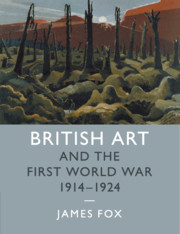Book contents
- Frontmatter
- Contents
- List of plates
- List of figures
- Acknowledgements
- Introduction
- 1 The outbreak of war and the business of art
- 2 Perceptions of art
- 3 The arts mobilize
- 4 War pictures: truth, fiction, function
- 5 Peace pictures: escapism, consolation, catharsis
- 6 Art and society after the war
- Conclusion
- Notes
- Bibliography
- Index
- Index
Conclusion
Published online by Cambridge University Press: 05 August 2015
- Frontmatter
- Contents
- List of plates
- List of figures
- Acknowledgements
- Introduction
- 1 The outbreak of war and the business of art
- 2 Perceptions of art
- 3 The arts mobilize
- 4 War pictures: truth, fiction, function
- 5 Peace pictures: escapism, consolation, catharsis
- 6 Art and society after the war
- Conclusion
- Notes
- Bibliography
- Index
- Index
Summary
In his autobiography of 1965, the influential British arts administrator John Rothenstein – who had only the previous year retired from the Tate Gallery, where he had been director since 1938 – confessed that the First World War had made ‘curiously little impact’ on his life. Rothenstein had good reasons for making such a claim: he was only thirteen years old at the outbreak of war; he had not fought on the front line; and even the awful events he did recall had, he admitted, taken on a ‘hideous normality’ at the time. Nevertheless, despite his almost complete absence of firsthand experience, Rothenstein's visual recollection of the conflict was extraordinarily vivid. He described his mental image of the western front as ‘a long wide swathe of pestiferous mud, blasted tree-stumps and barbed wire, lit up at night by Verey lights and starshells’. And he added: ‘Even for those of us who never saw it it was as familiar as our own back yards; it remains in my own memory more indelibly than any scene of bomb devastation inflicted on London during the Second World War, of which I was a continuous witness.’
Rothenstein's passage is extremely revealing, for it gives some indication of the First World War's enduring visual resonance. Rothenstein, after all, was not remembering the conflict as a historical event, or a personal narrative or even as a human tragedy; he was remembering it as an image. Perhaps this was the natural expression of a man who had lived through a century in which visuality had become such a dominant cultural paradigm; or perhaps it betrayed the fact that, as Jay Winter has claimed, ‘in wartime, images overwhelm words’. Yet if these explanations are indeed the case, why would Rothenstein not have had a similarly vivid visual recollection of the Second World War, of which he had extensive experience? The reason, I suspect, is art. Britain's artists, after all, arguably played a more decisive role in the representation of the 1914–18 war than in any conflict before or since, producing a formidable set of images that were ‘barely escapable’ during the conflict and increasingly influential in its aftermath.
The evidence for this argument is contained in the image that Rothenstein himself had recalled: ‘A long wide swathe of pestiferous mud … blasted tree-stumps and barbed wire … Verey lights and starshells’.
- Type
- Chapter
- Information
- British Art and the First World War, 1914–1924 , pp. 157 - 161Publisher: Cambridge University PressPrint publication year: 2015



